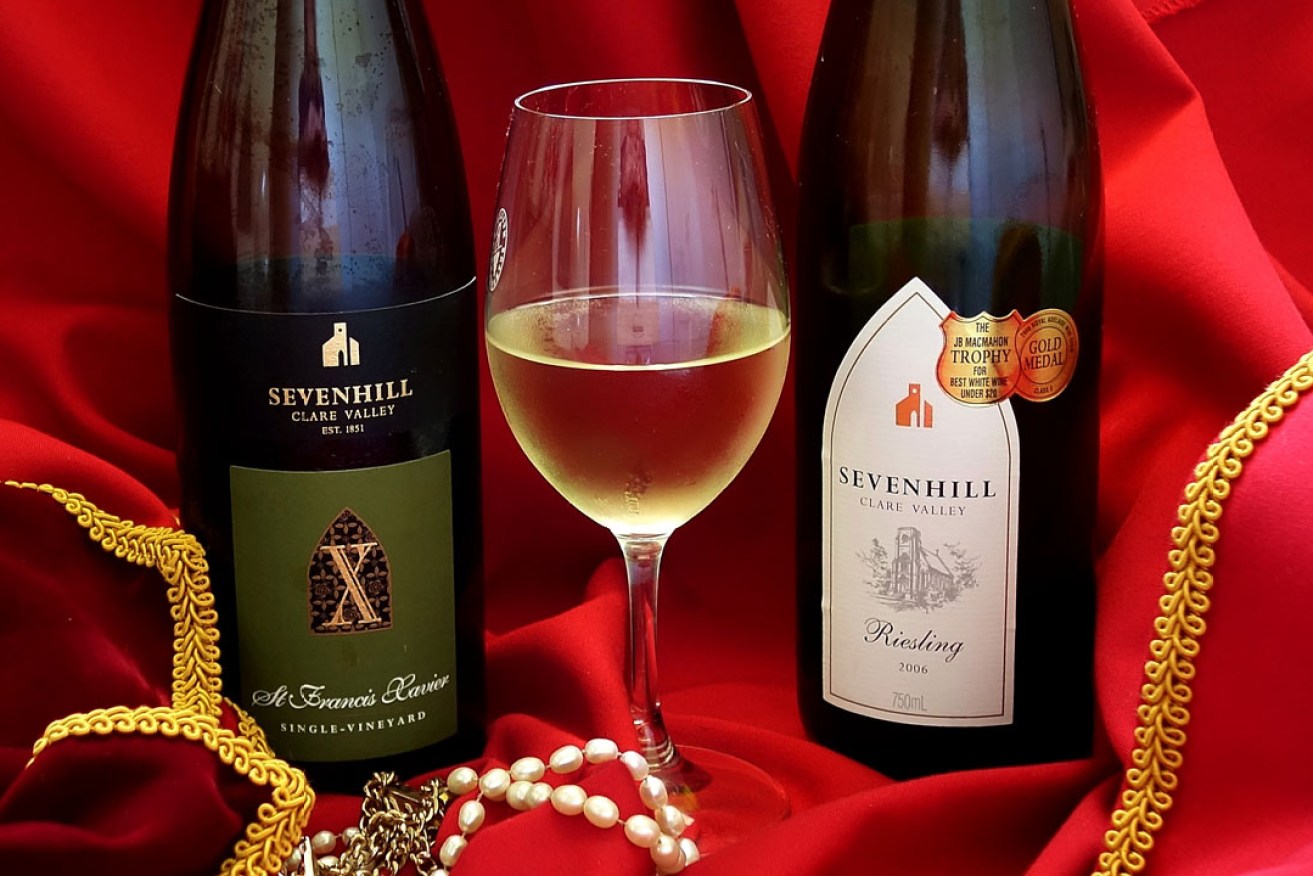Another visit to the Jesuits
Whitey revisits St Francis Xavier and commits the unforgiveable sin – likening aged Sevenhill Riesling to Burgundian Chardonnay.


A glass of bliss. Photo: Philip White
Slightly smoky, like prosciutto or gently-smoked bacon fat. Slightly acrid, like burlap, cordite, and the Mintaro slate quarry after they’ve split a big slab off in the summer sun. And then it’s pungent with that smug aroma of Grandma’s lime-and-ginger marmalade on buttered white toast.
I’m sniffing the Sevenhill Clare Valley Riesling 2006, which won the JB MacMahon Trophy for best white wine under $20 at the Royal Adelaide Wine Show of that year.
Take a schlück. My goodness. It’s a rich and generous feeling with a flavour like a miracle smoothie that somehow combines all those aromas into a burnished mellow brilliance with the smooth glow of brass like you hear in Van Dyke Parks’ Cannon in D. The aftertaste, with its persistent but polite wedge of firm acidity seems to turn a spotlight on the whole shiny performance.
This experience is very much like one can derive from a mild mature Burgundian Chardonnay. That smoke emulates the toasted oak such wines involve. The cordite is like the nose-prickling mixture of sulphur and yeast you’ll find most prominently in a younger Burgundy. Add a few slices of stewed white peach to your marmalade on toast and you have a flavour uncannily similar to good Chardonnay.
The biggest difference? The flavour of this beautiful calm Riesling shows no oak. Apart from that semblance of toasted oak in the fragrance, there’s none in the palate, which only serves to make that part of it vaguely resemble an aged Chardonnay from Chablis, that satellite sub-region of Burgundy heading north towards Champagne, where it’s cooler and they don’t use much wood. But while the wines there are grown in Kimmeridgian chalk and clay rich in marine fossils, they can sure smell and taste slaty.
My point being? Good Burgundy usually starts at $120, not $20. While the newest Sevenhill model of this Riesling may have crept upwards a dollar or two, there’s still a $100-plus gap before you hit much Burgundy worth your trouble.
Considering this is what happens if you can afford to cellar $20 Riesling for a decade, it’s important to see what happens if you have the 20 but not the time. So let’s peel the finest rizza from Elizabeth Heidenreich, who makes the wine there with Brother John May, SJ, for the Jesuits of Sevenhill.
Sevenhill St Francis Xavier Clare Valley Single Vineyard Riesling 2016
($35; 11% alcohol; screw cap)
Yeah, I know, I know: this one’s $35. That’s because, unlike the standard $22 jobbie, this is from the best tiny patch of Riesling on the monastery: it’s their top Riesling.
Which, knowing the acuity of its makers, suggests to me it’ll do an even better job than the less spendy model.
And yes, I did attempt a review of this wine in August, when it was so young it couldn’t talk. Now, half a year older, it really deserves a second look: it’s putting on flesh. It shows even more promise.
Lime pith, sliced fresh ginger root, all manner of citrus blossom, and not so much slate or chalk but hard red dirt in the summer, just slightly prickly. Stubble. Rustling everlasting flowers on the headlands. That’ll be your bouquet.
Schlück. Elegance. Intensity. Lime and lemon juice. Dust. It’s all locked in and tight as a drum. Adult. Austere. Grainy. Slaty, as if you were licking the lichen from an old Sevenhill tombstone. It’s sufficiently majestic and removed to barely notice you.
Which all sounds a bit droll. If your palate is not attuned to very fine young Rieslings, and you need more instant gratification, go for the $22 one. But if you’re even halfway to full-bore Riesling pervitude, this will play your brass for you.
The major difference being? I reckon that while this grand wine will take a lot longer to burnish and soften, it will remain more classically Riesling-like; it’ll grow toasty and marmalady for many years before it makes me think of the expensive Chardonnays of Burgundy.
If indeed it ever does. Maybe the Burgundy richistanis should stick to cheaper Rizza. Maybe that’s where most of Burgundy resides: down there, well below the ranks of truly magnificent Rieslings like this.
There. I’ve said that, too. Better said than dead, eh?
One final point. These Rieslings don’t smell of the kero/flytox/petroleum stuff many British wine critics seem to expect of good Australian Rieslings. An honest winemaker will tell you that aroma is a fault brought on by lazy vineyard management: it’s often the smell of berries burnt too much by the hot summer sun. Keep those grapes safe and fresh in mottled leafy shade, and you get no kero.
You get serious grown-up bliss.
drinkster.blogspot.com




